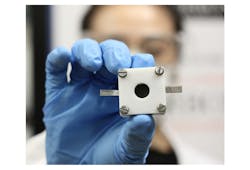Rechargeable Zinc-Air Batteries Could Threaten Li-ion’s Dominance
Download this article in PDF format.
Current research on zinc-air batteries aims to transform this battery type from non-rechargeable to rechargeable. To describe how rechargeable zinc-air batteries work, we first have to look at their existing non-rechargeable counterparts, which are metal-air batteries activated by oxidizing zinc with oxygen from the air.
Non-rechargeable sizes range from very small button cells for hearing aids, to larger types used in cameras. You can’t use zinc-air batteries in a sealed battery holder because some air must come in. This battery requires oxygen in 1 liter of air for every ampere-hour of capacity.
During the discharge of a non-rechargeable zinc-air battery, a mass of zinc particles forms a porous anode, which is saturated with an electrolyte. Oxygen from the air reacts at the cathode and forms hydroxyl ions that migrate into the zinc paste and form zincate, releasing electrons to travel to the cathode. The zincate decays into zinc oxide and water that returns to the electrolyte. The water and hydroxyl from the anode are recycled at the cathode, so the water is not consumed. These reactions produce a theoretical 1.65 V, but this reduces to 1.35-1.4 V in practical cells.
It’s in the Air
Non-rechargeable zinc-air batteries have higher energy density and specific energy (and weight) ratio than other types of battery because atmospheric air is one of the battery reactants. The air is not packaged with the battery; therefore, a cell can use more zinc in the anode than a cell that must also contain, for example, manganese dioxide. This increases capacity for a given weight or volume. As a specific example, a zinc-air battery from one manufacturer with a 11.6 mm diameter and 5.4 mm height has a capacity of 620 mAh and weighs 1.9 g; various silver oxide and alkaline cells of the same size supply have a 150- to 200-mAh capacity and weigh 2.3-2.4 g.
These zinc-air cells have long shelf life if sealed to keep air out. Even miniature button cells can be stored for up to three years at room temperature with little capacity loss if their seal is not removed. Industrial cells stored in a dry state have an indefinite storage life.
The operating life of a zinc-air cell is a critical function of its interaction with the environment. The electrolyte loses water more rapidly in conditions of high temperature and low humidity. Because its potassium-hydroxide electrolyte is deliquescent, in very humid conditions excess water accumulates in the cell, flooding the cathode and destroying its active properties. Potassium hydroxide also reacts with atmospheric carbon dioxide; carbonate formation eventually reduces electrolyte conductivity.
Because the cathode does not change properties during discharge, terminal voltage is quite stable until the cell approaches exhaustion. Its power capacity is a function of:
- Cathode area
- Air availability
- Porosity
- Catalytic value of the cathode surface
Oxygen entry into the cell must be balanced against electrolyte water loss. Cathode membranes are coated with (hydrophobic) Teflon material to limit water loss. Low humidity increases water loss; if enough water is lost the cell fails. Button cells have a limited current drain. For example, an IEC PR44 cell has a capacity of 600 mAh, but a maximum current of only 22 mA. Pulse load currents can be much higher since some oxygen remains in the cell between pulses.
Though low temperature reduces primary cell capacity, the effect is small for low drains. A cell may deliver 80% of its capacity if discharged over 300 hours at 0°C, but only 20% of capacity if discharged at a 50-hour rate at that temperature. Lower temperature also reduces cell voltage.
Non-rechargeable zinc-air batteries have some properties similar to fuel cells as well as batteries: the zinc is the fuel, the reaction rate can be controlled by varying the air flow, and oxidized zinc/electrolyte paste can be replaced with fresh paste.
News_ Due to the global abundance of zinc metal, these batteries are much cheaper to produce than lithium-ion batteries. On top of that, they can store more energy (theoretically five times more than that of lithium-ion batteries), and are much safer and more environmentally friendly.
Leading the Charge on Recharging Issues
Widespread use of zinc-air batteries has been hindered by the fact that, up until now, recharging them has been difficult. This is due to the lack of electrocatalysts that successfully reduce and generate oxygen during the discharging and charging of a battery.
A new three-stage method to overcome this recharging problem was recently described in Advanced Materials. The article was authored by chemical engineering researchers from the University of Sydney (Australia) and Nanyang Technological University (Singapore).
Rechargeable zinc-air batteries show promise as a viable power-source option to lithium-ions.
According to lead author Professor Yuan Chen, from the University of Sydney’s Faculty of Engineering and Information Technologies, the new method can be used to create bifunctional oxygen electrocatalysts for building rechargeable zinc-air batteries from scratch. The figure shows a prototype of one of their rechargeable zinc-air batteries.
“Up until now, rechargeable zinc-air batteries have been made with expensive precious metal catalysts, such as platinum and iridium oxide,” he said. “In contrast, our method produces a family of new high-performance and low-cost catalysts.”
These new catalysts can then be applied to build rechargeable zinc-air batteries. They are produced through the simultaneous control of their:
- Composition
- Size
- Crystallinity of metal oxides of iron, cobalt and nickel
Paper co-author Dr Li Wei, also from the University’s Faculty of Engineering and Information Technologies, said trials of zinc-air batteries developed with the new catalysts had demonstrated excellent rechargeability—including less than a 10% battery efficacy drop over 60 discharging/charging cycles of 120 hours.
“We are solving fundamental technological challenges to realize more sustainable metal-air batteries for our society,” added Professor Chen.
Research on zinc-air batteries is also ongoing at the University of Waterloo in Canada. Their research focus is on the development of novel bifunctional catalysts capable of catalyzing both the oxygen reduction (battery discharge) and oxygen evolution (battery recharge) reactions to create practically viable rechargeable zinc-air batteries. In addition, they focus on the design and performance optimization of both air and zinc electrodes as well as a solid electrolyte membrane. Finally, their aim is to combine the components into various forms of a rechargeable zinc-air battery, such as stationary, flexible, and flow cells.
Like most research projects some questions arise:
1. Do these rechargeable versions have similar energy density and specific energy (and weight) as the existing non-rechargeable types?
2. What is the effect of temperature change on these rechargeable batteries?
3. How many times can these batteries be charged and recharged and still maintain the expected output voltage?
4. They produce a lower output voltage, so how can rechargeable zinc-air batteries compete with lithium-ion?
5. How does humidity affect performance of the rechargeable battery?
6. Are there electronic system packaging problems because these rechargeable batteries require access to air?
7. Does the design prototype produced by research lend itself to mass production of rechargeable batteries?
8. Will these rechargeable batteries be able to power electric vehicles?
About the Author

Sam Davis
Sam Davis was the editor-in-chief of Power Electronics Technology magazine and website that is now part of Electronic Design. He has 18 years experience in electronic engineering design and management, six years in public relations and 25 years as a trade press editor. He holds a BSEE from Case-Western Reserve University, and did graduate work at the same school and UCLA. Sam was the editor for PCIM, the predecessor to Power Electronics Technology, from 1984 to 2004. His engineering experience includes circuit and system design for Litton Systems, Bunker-Ramo, Rocketdyne, and Clevite Corporation.. Design tasks included analog circuits, display systems, power supplies, underwater ordnance systems, and test systems. He also served as a program manager for a Litton Systems Navy program.
Sam is the author of Computer Data Displays, a book published by Prentice-Hall in the U.S. and Japan in 1969. He is also a recipient of the Jesse Neal Award for trade press editorial excellence, and has one patent for naval ship construction that simplifies electronic system integration.
You can also check out his Power Electronics blog.


